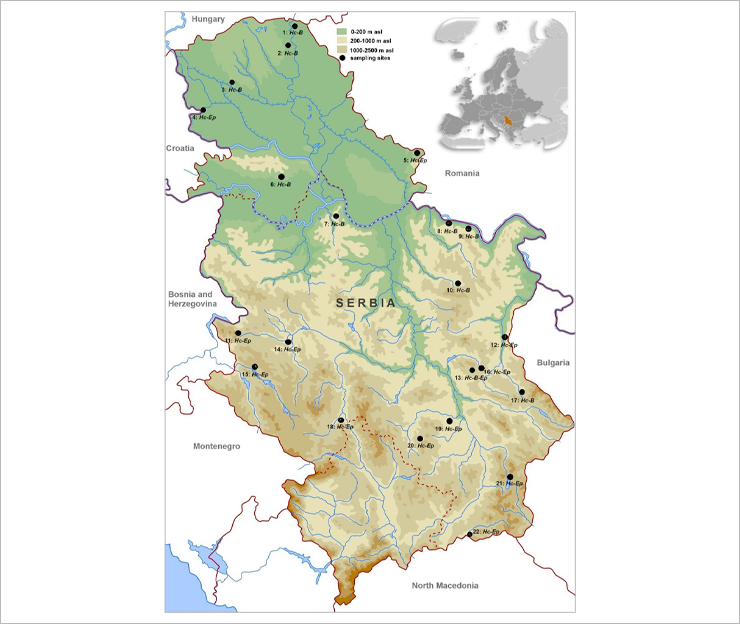Comparative biomonitoring of airborne PTEs using mosses and lichen
News, 18 September 2024
Scientists from the JINR Laboratory of Neutron Physics and research centres in Romania and Serbia conducted comparative biomonitoring of airborne potentially toxic elements (PTEs) using mosses (Hypnum cupressiforme, Brachythecium spp.) and lichens (Evernia prunastri) over remote areas.
The selection of the appropriate biomonitor species is a crucial criterion for biomonitoring on a broad spatial scale. Mosses Hypnum cupressiforme and Brachythecium spp. and lichen Evernia prunastri were sampled at 22 remote sites over Serbia aiming interspecies comparison of their bioconcentration capacities.
 Geomorphological map of Sebia with network of the sampling sites (1–22) over remote areas: Hc, Hypnum cupressiforme; B, Brachythecium spp., and Ep, Evernia prunastri
Geomorphological map of Sebia with network of the sampling sites (1–22) over remote areas: Hc, Hypnum cupressiforme; B, Brachythecium spp., and Ep, Evernia prunastri
16 PTEs were detected in the samples: Al, Ba, Cd, Co, Cr, Cu, Fe, Hg, Mn, Ni, P, Pb, S, Sr, V, and Zn. Between the co-located mosses, linear regression analysis (type II) showed significant determination coefficients only for a couple of the elements (Cd and S), while for H. cupressiforme vs. lichen, significant regression lines were obtained for a broader set of elements (Ba, Cd, Fe, Hg, Mn, Ni, Sr).
The ratio of the PTEs in the mosses discovered higher concentrations in H. cupressiforme at some sites and in Brachythecium spp. at other sites. According to the PTE ratios, H. cupressiforme accumulated much more element content than the lichen. In addition, principal component analysis (PCA) pointed out a different grouping of the PTEs depending on the biomonitor species tested. The poor correlation of the moss-moss data is perhaps because several species of the genus Brachythecium were sampled, which possibly influenced the average genus accumulation capacity. In addition, morphological features of the mosses (concave vs. flat leaflets, creeping vs. cushiony life form) presumably delegate differences in PTE accumulation.
In conclusion, researchers highlighted the need to be careful when using several biomonitor species, even of the same genus, within the same study.
The article was published in Environmental Science and Pollution Research in July 2024. Among the authors are JINR employees: Konstantin Vergel, Nikita Yushin, Omari Chaligava, and Inga Zinicovscaia.